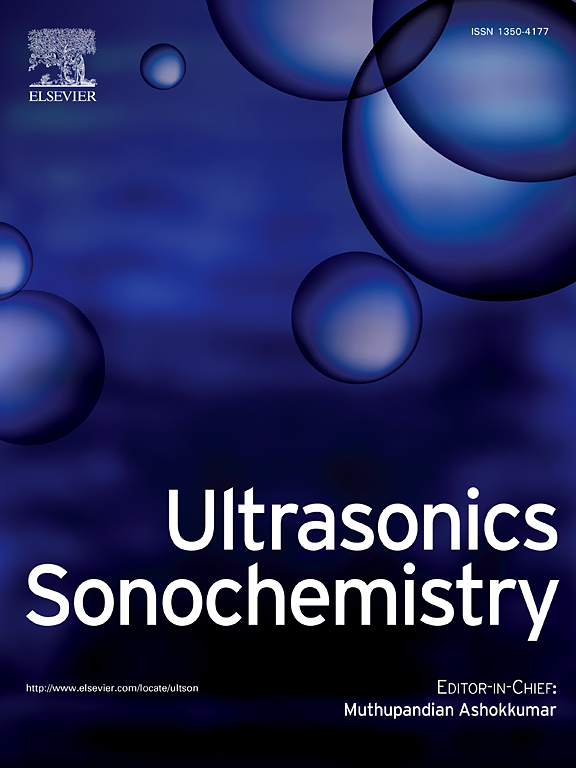Ultrasonic-assisted separation and extraction of submicron and nano-sized straw particles: Reconstruction of physicochemical characteristics and a promising breakthrough in overcoming technical bottlenecks of straw return to the field
IF 9.7
1区 化学
Q1 ACOUSTICS
引用次数: 0
Abstract
Addressing the issues of slow decomposition and low nutrient release efficiency associated with traditional straw returning, this study innovatively applied ultrasound-assisted centrifugal separation technology to prepare submicron/nano-straw particles and systematically conducted a multi-scale investigation from microscopic to macroscopic levels. The core finding reveals that when the particle size reaches the 1 μm threshold, ultrasonic cavitation vigorously disrupts the straw structure, leading to efficient lignin removal (77.45 %) and a significant reduction in cellulose crystallinity, thereby fundamentally enhancing the degradation rate. Concurrently, the cavitation effect optimizes elemental ratios (e.g., C, N, and K elemental proportions increasing by 1.05 to 8.50 times) and exposes active functional groups such as C–N and N–H bonds, effectively overcoming the bottleneck in nutrient release. Furthermore, cavitation increases the abundance of hydrophilic groups on the straw surface, enhancing its water-holding capacity by 13.84–18.52 %. Soil columns experiment and pot trials confirmed that the nano-straw prepared by this technology substantially reduces nutrient loss, significantly increases soil available potassium content, ultimately synergistically increasing rice yield by 25.27 %. In summary, by simultaneously optimizing the straw’s degradability, fast-acting nutrient release capacity, and water retention, ultrasonic technology solves the core challenges of traditional straw returning and provides a novel strategy for developing new fast-acting straw fertilizers.

超声辅助分离提取亚微米和纳米级秸秆颗粒:重建秸秆理化特性,有望突破秸秆还田技术瓶颈
针对传统秸秆还田分解缓慢、养分释放效率低的问题,本研究创新性地应用超声辅助离心分离技术制备亚微米/纳米秸秆颗粒,系统地进行了从微观到宏观的多尺度研究。核心发现表明,当粒径达到1 μm阈值时,超声空化对秸秆结构产生强烈破坏,木质素的去除率达到77.45%,纤维素结晶度显著降低,从而从根本上提高了降解率。同时,空化效应优化了元素比例(如C、N、K元素比例提高了1.05 ~ 8.50倍),暴露了C - N、N - h键等活性官能团,有效克服了养分释放的瓶颈。此外,空化增加了秸秆表面亲水性基团的丰度,使其持水能力提高了13.84 ~ 18.52%。土壤柱试验和盆栽试验证实,该技术制备的纳米秸秆大幅度减少了养分流失,显著提高了土壤速效钾含量,最终协同提高水稻产量25.27%。综上所述,超声波技术通过同时优化秸秆的降解性、速效养分释放能力和保水能力,解决了传统秸秆还草的核心挑战,为开发新型速效秸秆肥料提供了新的策略。
本文章由计算机程序翻译,如有差异,请以英文原文为准。
求助全文
约1分钟内获得全文
求助全文
来源期刊

Ultrasonics Sonochemistry
化学-化学综合
CiteScore
15.80
自引率
11.90%
发文量
361
审稿时长
59 days
期刊介绍:
Ultrasonics Sonochemistry stands as a premier international journal dedicated to the publication of high-quality research articles primarily focusing on chemical reactions and reactors induced by ultrasonic waves, known as sonochemistry. Beyond chemical reactions, the journal also welcomes contributions related to cavitation-induced events and processing, including sonoluminescence, and the transformation of materials on chemical, physical, and biological levels.
Since its inception in 1994, Ultrasonics Sonochemistry has consistently maintained a top ranking in the "Acoustics" category, reflecting its esteemed reputation in the field. The journal publishes exceptional papers covering various areas of ultrasonics and sonochemistry. Its contributions are highly regarded by both academia and industry stakeholders, demonstrating its relevance and impact in advancing research and innovation.
 求助内容:
求助内容: 应助结果提醒方式:
应助结果提醒方式:


